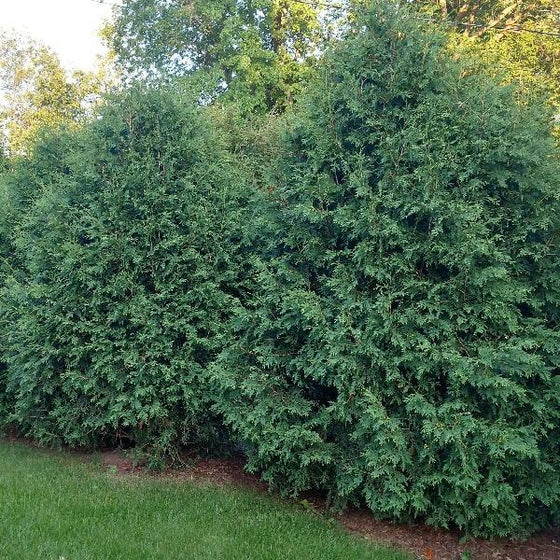
Images Depict Mature Plants
Thuja Nigra Trees for Sale Online
Thuja Nigra is one of the best varieties for cold climates and will keep its dark green color all winter long. It is hardy in USDA zones 3 – 7, which cover a massive portion of the United States. Thuja Nigra is the native hedging and screening plant of choice. When crushed, the flat, delicate, dark-green foliage emits a pleasantly sweet aroma. It isn’t picky about soil and will grow in sandy and heavy clay soils equally well. It is also practically maintenance-free. The only major maintenance is hedge shearing after several years of growth. Unlike some evergreen plants, Thuja Nigra has few pest and disease problems. If you’ve had issues with Leyland Cypress or Arborvitae Emerald Green in your yard, this plant is a great replacement.



| Hardiness Zone: | 3-8 |
|---|---|
| Mature Height: | 15 to 20 feet |
| Mature Width: | 5 to 10 feet |
| Sunlight: | Full Sun |
| Foliage color: | Dark Green |
| Soil Conditions: | any type of soil |
| Water Requirements: | Water until established |
| Growth Rate: | Moderate |
How to Care for Thuja Nigra Arborvitae
Never plant trees deeper than originally planted in the pot. Doing so can cause rotting of the stem and death to the tree. Thuja Nigra Arborvitaes are very drought tolerant, however they grow very slow without adequate water. Staking young trees is recommended. When tying trees to stakes remember the tree will continue to grow. Loosely tie the Thuja Nigra with several twist ties to allow for growth. Check trees every three months and loosen as needed. If this is not done, the twist tie will grow into the tree causing injury. The one question that comes up often, “when is the best time to plant.”? For the most part, container trees can be planted year around, provided the ground isn’t frozen. Below Virginia many nurseries and Christmas tree growers field plant year around, weather permitting. When planting a potted Thuja Nigra Arborvitae, remember the only water source the tree has, is its small root ball, and all the water the tree uses must come from there until new roots can grow into the surrounding soil.After back filling and lightly compacting the 50/50 mix of existing soil and compost give the plant a good deep watering. This is not to be rushed. most of the water you put on the plant at first will run away from the plant until the soil is soaked. A general rule of thumb is to count to 5 for every one gallon of pot size. For example a one gallon pot would be watered until you count to 5 a three gallon pot would be 15 and so on. Check the plant daily for the first week or so and then every other day there after. Water using the counting method for the first few weeks. More plants die from being over-watered rather than under-watered.










